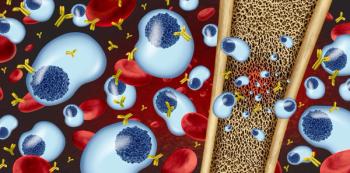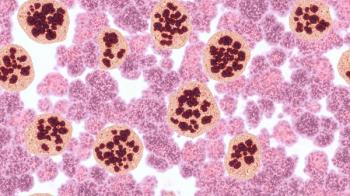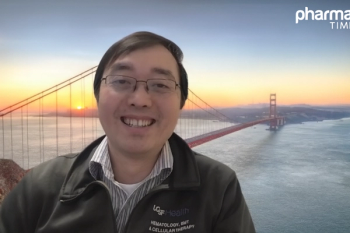
EHA 2025: No Added Toxicity Observed With Bleximenib Plus Venetoclax and Azacitidine in AML
Andrew H. Wei, PhD, discusses phase 1b findings on the safety, pharmacokinetics, and preliminary efficacy of combining the menin inhibitor bleximenib with venetoclax and azacitidine in patients with newly diagnosed or relapsed/refractory acute myeloid leukemia (AML) harboring NPM1 mutations or KMT2A rearrangements.
At the 2025 European Hematology Association (EHA) Congress, Andrew H. Wei, PhD, and colleagues presented updated results from the phase 1b dose-escalation study evaluating the menin inhibitor bleximenib (JNJ 75276617; Johnson & Johnson) in combination with venetoclax (Venclexta; AbbVie Inc) and azacitidine in patients with either newly diagnosed (ND) or relapsed/refractory (R/R) acute myeloid leukemia (AML) harboring NPM1 mutations or KMT2A rearrangements. The study builds on growing interest in menin inhibition as a therapeutic strategy targeting epigenetic dysregulation in AML subtypes driven by NPM1 mutations or KMT2A rearrangements.
In this interview with Pharmacy Times®, Wei discusses key findings from the trial, including the rationale behind dose selection, the absence of pharmacokinetic drug-drug interactions, and emerging response data across genetic subgroups. He also addresses how these data are shaping the ongoing phase 3 cAMeLot-2 trial (NCT06852222), now enrolling patients with newly diagnosed NPM1 mutations or KMT2A rearrangements AML who are ineligible for intensive chemotherapy.
Pharmacy Times: How did the dosing ranges differ between the ND AML and R/R cohorts, and what guided those starting doses?
Andrew H. Wei, PhD: Dose escalation in phase 1 for all cohorts (ND and R/R) were guided by Bayesian Optimal Interval statistical design per protocol. The dosing cycles consisted of 28 days, with dosing of bleximenib commencing on cycle 1 day 4 after a 3-day dosing ramp up with venetoclax to full treatment dose of 400 mg daily per approved label and standard dose of azacitidine daily for both cohorts.
Bleximenib dose levels explored, in combination with venetoclax plus azacitidine, across both R/R and ND cohorts ranged from 15 mg twice daily up to 150 mg twice daily.
Pharmacy Times: Were there any pharmacokinetic concerns or drug-drug interactions (DDIs) anticipated or observed between bleximenib, venetoclax, and azacitidine?
Wei: No dose modifications to standard of care venetoclax plus azacitidine co-agents were required when combining with bleximenib with no evidence of DDI:
- Exposures of bleximenib in combination with venetoclax with or without azacitidine were similar to exposures observed with bleximenib monotherapy.
- Exposures of venetoclax in combination with bleximenib plus azacitidine were similar to published data.
Pharmacy Times: Given that nearly half of R/R patients had prior venetoclax exposure, how might this impact the interpretation of response rates with the triple combination?
Wei: Responses were observed in patients with prior venetoclax exposure receiving bleximenib 100 mg twice daily plus venetoclax with azacitidine in R/R setting.
Pharmacy Times: Differentiation syndrome (DS) was observed in 4% of patients—how was this monitored and managed, particularly given the known risks with venetoclax combinations?
Wei:Protocol-specified guidance to mitigate and manage the risk of DS includes:
- Staggered initiation of bleximenib dosing on cycle 1 day 4
- Prophylactic use of steroids and/or hydroxyurea particularly for participants considered to be at high-risk for the development of severe DS (eg, high disease burden, high presenting white blood cell count, Eastern Cooperative Oncology Group score of 2, adverse cytogenetics, etc)
- Prompt interruption of bleximenib for any potential/confirmed DS
- Low threshold for initiating supportive care treatment doses of steroids and hydroxyurea for any signs of symptoms suggestive of emerging DS
Pharmacy Times: Given the hematologic toxicity profile, were there any specific dose holds or modifications recommended during count recovery?
Wei: Bleximenib was given continuously on 28-day cycles starting on cycle 1 day 4. Proteasome inhibitors were instructed to follow protocol for dose modifications of bleximenib if a cytopenia was assessed as related to bleximenib. Of note, time to count recovery was not delayed significantly when bleximenib was combined with venetoclax plus azacitidine, suggesting no additive hematology toxicity with the combination.
Pharmacy Times: Did you observe any correlation between reduction in NPM1 mutational burden and clinical response in the ND vs R/R setting?
Wei: This is currently under investigation and yet to be reported.
Pharmacy Times: Were there any differences in depth or durability of response between patients with NPM1 mutations vs KMT2A rearrangements?
Wei: High rates of response observed in both participants with KMT2A rearrangements and NPM1 mutations. Small sample size makes it difficult to draw conclusions about the impact of genetic alterations on response.
For the R/R AML cohort: At 100 mg bleximenib plus venetoclax plus azacitidine, participants with KMT2A rearrangements had an overall response rate (ORR) of 70.0, while participants with NPM1 mutations had an ORR of 91.7.
For the ND AML cohort: At 100 mg bleximenib plus venetoclax plus azacitidine, participants with KMT2A rearrangements had an ORR of 75.0, while participants with NPM1 mutations had an ORR of 93.8. Minimal residual disease data are pending, so we cannot comment on the depth of responses at this time.
At the time of the Clinical Care Options on May 7, 2025 as presented at EHA: Median number of cycles of bleximenib 100 mg twice daily plus venetoclax plus azacitidine in R/R setting was 3 (range 1-13) and in ND setting was 3 (range 1-6). Of note, 5 (22.7%) R/R patients and 2 (10%) ND patients who received bleximenib 100 mg twice daily plus venetoclax plus azacitidine proceeded to transplant.
Pharmacy Times: How is this recommended phase 2 dose (RP2D) being integrated into the upcoming phase 3 p-2 study, and are there any changes to dosing schedule or eligibility based on Phase 1b findings?
Wei: The totality of clinical data informed bleximenib 100 mg BID as the RP2D when used in combination with venetoclax plus azacitidine for both R/R and ND AML with KMT2A rearrangements or NPM1 mutations, and bleximenib 100 mg twice daily is the proposed combination RP2D for the phase 3 cAMeLot-2 trial. The placebo-controlled phase 3 cAMeLot-2 trial investigating venetoclax plus azacitidine with or without bleximenib in participants with ND AML who are ineligible for intensive chemotherapy is now open and enrolling. No phase 1b findings informed changes to eligibility criteria.
Eligible participants must: be aged 18 or older with previously untreated with ND AML withKMT2A rearrangements or NPM1 mutations (≥10% blasts per 2022 International Consensus Classification criteria); be ineligible for intensive chemotherapy and have adequate hepatic function and a white blood cell count of under 25 x 109/L. Key exclusion criteria include known active leukemic involvement of the central nervous system, history of myelofibrosis, any prior hypomethylating or chemotherapeutic agent for myelodysplastic syndrome, or significant cardiac disease.
Newsletter
Stay informed on drug updates, treatment guidelines, and pharmacy practice trends—subscribe to Pharmacy Times for weekly clinical insights.




















































































































































































































